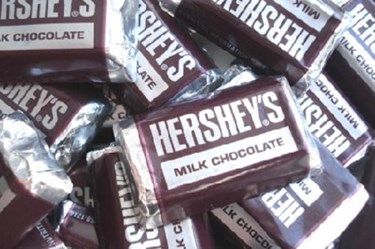Hershey Is Wrapping Up Sustainability Goals With Packaging Redesign
By Isaac Fletcher, contributing writer, Food Online

Along with a long list of other initiatives and projects, a new wrapper for Hershey’s Miniatures takes important steps toward sustainability and more eco-friendly, low-footprint manufacturing
Hershey has redesigned the packaging for its Hershey’s Miniatures to be more environmentally friendly, with each new wrapper using about 0.05 grams less material than the old ones. This reduction in material use may seem irrelevant on a smaller scale, but will save about 271,800 pounds of material per year. The reduction in paper use saves around 2,000 trees and reducing the amount of aluminum used, accompanied with the energy necessary for its production is equal to turning off the electricity in 56 homes for one year. The wrapping, while familiar, also looks different, with the modernized wording of favorites like Krackel and Mr. Goodbar that doesn’t entirely fit on the wrapper.
According to Hershey, the redesign went through a seamless implementation and had no impact on production efficiency. The company has more than 175 projects in the works just to increase the sustainability of its packaging. These efforts have saved about 14 million pounds of packaging material since they began five years ago.
On May 1, Hershey issued its third Corporate Social Responsibility (CSR) report, which shows how the company has progressed on its wide range of CSR goals. Since the company already completed many of its previous CSR goals ahead of schedule, the report also includes some new targets for the company to reach by 2017. Among these, the company hopes to complete at least 25 of its packaging related sustainability initiatives, which will cumulatively result in eliminating the need for 16 million pounds of packaging material.
The CSR report also highlighted some other targets and goals for Hershey to reach by 2017.
- Reduce greenhouse gas emissions by an additional 10 percent
- Attain zero-waste landfill status at two more plants
- Attain a recycling rate of at least 90 percent
- Reduce waste by another five percent
- Reduce water use by an additional 17 percent
John P. Bilbrey, President and CEO of Hershey, says, “Since our original goals were set, we have learned a lot about where we could make a difference and what would make the most impact where it matters.” He adds, “Our CSR strategies have evolved, and the updated framework we share in this report reflects how our company values guide the way we work, and how our CSR efforts have matured, become more focused and better aligned with our business.” Sustainability in food has really come into the spotlight recently, and large producers, like Hershey, are finding great value — in terms of both production and consumer relations — through sustainability initiatives.
